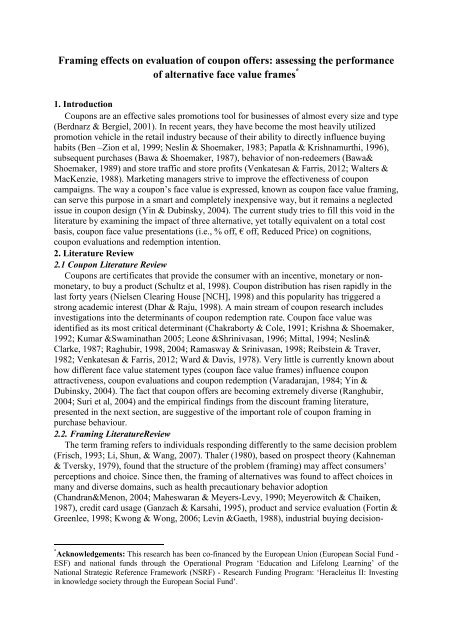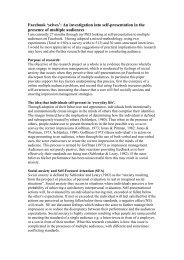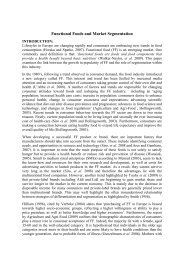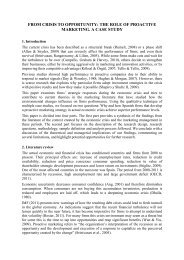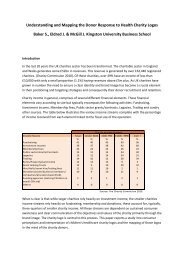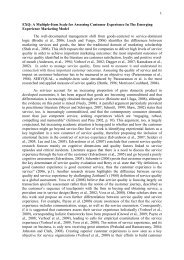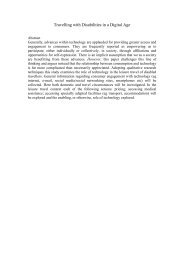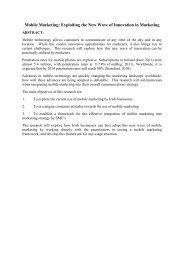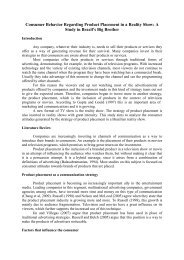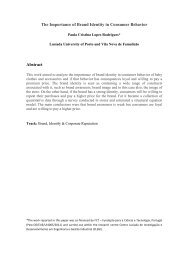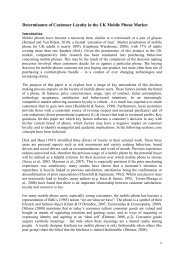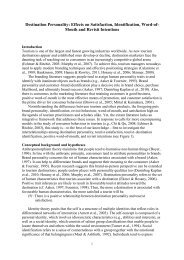Framing effects on evaluation of coupon offers: assessing the ...
Framing effects on evaluation of coupon offers: assessing the ...
Framing effects on evaluation of coupon offers: assessing the ...
You also want an ePaper? Increase the reach of your titles
YUMPU automatically turns print PDFs into web optimized ePapers that Google loves.
<str<strong>on</strong>g>Framing</str<strong>on</strong>g> <str<strong>on</strong>g>effects</str<strong>on</strong>g> <strong>on</strong> evaluati<strong>on</strong> <strong>of</strong> coup<strong>on</strong> <strong>of</strong>fers: <strong>assessing</strong> <strong>the</strong> performance<br />
<strong>of</strong> alternative face value frames *<br />
1. Introducti<strong>on</strong><br />
Coup<strong>on</strong>s are an effective sales promoti<strong>on</strong>s tool for businesses <strong>of</strong> almost every size and type<br />
(Berdnarz & Bergiel, 2001). In recent years, <strong>the</strong>y have become <strong>the</strong> most heavily utilized<br />
promoti<strong>on</strong> vehicle in <strong>the</strong> retail industry because <strong>of</strong> <strong>the</strong>ir ability to directly influence buying<br />
habits (Ben –Zi<strong>on</strong> et al, 1999; Neslin & Shoemaker, 1983; Papatla & Krishnamurthi, 1996),<br />
subsequent purchases (Bawa & Shoemaker, 1987), behavior <strong>of</strong> n<strong>on</strong>-redeemers (Bawa&<br />
Shoemaker, 1989) and store traffic and store pr<strong>of</strong>its (Venkatesan & Farris, 2012; Walters &<br />
MacKenzie, 1988). Marketing managers strive to improve <strong>the</strong> effectiveness <strong>of</strong> coup<strong>on</strong><br />
campaigns. The way a coup<strong>on</strong>’s face value is expressed, known as coup<strong>on</strong> face value framing,<br />
can serve this purpose in a smart and completely inexpensive way, but it remains a neglected<br />
issue in coup<strong>on</strong> design (Yin & Dubinsky, 2004). The current study tries to fill this void in <strong>the</strong><br />
literature by examining <strong>the</strong> impact <strong>of</strong> three alternative, yet totally equivalent <strong>on</strong> a total cost<br />
basis, coup<strong>on</strong> face value presentati<strong>on</strong>s (i.e., % <strong>of</strong>f, € <strong>of</strong>f, Reduced Price) <strong>on</strong> cogniti<strong>on</strong>s,<br />
coup<strong>on</strong> evaluati<strong>on</strong>s and redempti<strong>on</strong> intenti<strong>on</strong>.<br />
2. Literature Review<br />
2.1 Coup<strong>on</strong> Literature Review<br />
Coup<strong>on</strong>s are certificates that provide <strong>the</strong> c<strong>on</strong>sumer with an incentive, m<strong>on</strong>etary or n<strong>on</strong>m<strong>on</strong>etary,<br />
to buy a product (Schultz et al, 1998). Coup<strong>on</strong> distributi<strong>on</strong> has risen rapidly in <strong>the</strong><br />
last forty years (Nielsen Clearing House [NCH], 1998) and this popularity has triggered a<br />
str<strong>on</strong>g academic interest (Dhar & Raju, 1998). A main stream <strong>of</strong> coup<strong>on</strong> research includes<br />
investigati<strong>on</strong>s into <strong>the</strong> determinants <strong>of</strong> coup<strong>on</strong> redempti<strong>on</strong> rate. Coup<strong>on</strong> face value was<br />
identified as its most critical determinant (Chakraborty & Cole, 1991; Krishna & Shoemaker,<br />
1992; Kumar &Swaminathan 2005; Le<strong>on</strong>e &Shrinivasan, 1996; Mittal, 1994; Neslin&<br />
Clarke, 1987; Raghubir, 1998, 2004; Ramasway & Srinivasan, 1998; Reibstein & Traver,<br />
1982; Venkatesan & Farris, 2012; Ward & Davis, 1978). Very little is currently known about<br />
how different face value statement types (coup<strong>on</strong> face value frames) influence coup<strong>on</strong><br />
attractiveness, coup<strong>on</strong> evaluati<strong>on</strong>s and coup<strong>on</strong> redempti<strong>on</strong> (Varadarajan, 1984; Yin &<br />
Dubinsky, 2004). The fact that coup<strong>on</strong> <strong>of</strong>fers are becoming extremely diverse (Ranghubir,<br />
2004; Suri et al, 2004) and <strong>the</strong> empirical findings from <strong>the</strong> discount framing literature,<br />
presented in <strong>the</strong> next secti<strong>on</strong>, are suggestive <strong>of</strong> <strong>the</strong> important role <strong>of</strong> coup<strong>on</strong> framing in<br />
purchase behaviour.<br />
2.2. <str<strong>on</strong>g>Framing</str<strong>on</strong>g> LiteratureReview<br />
The term framing refers to individuals resp<strong>on</strong>ding differently to <strong>the</strong> same decisi<strong>on</strong> problem<br />
(Frisch, 1993; Li, Shun, & Wang, 2007). Thaler (1980), based <strong>on</strong> prospect <strong>the</strong>ory (Kahneman<br />
& Tversky, 1979), found that <strong>the</strong> structure <strong>of</strong> <strong>the</strong> problem (framing) may affect c<strong>on</strong>sumers’<br />
percepti<strong>on</strong>s and choice. Since <strong>the</strong>n, <strong>the</strong> framing <strong>of</strong> alternatives was found to affect choices in<br />
many and diverse domains, such as health precauti<strong>on</strong>ary behavior adopti<strong>on</strong><br />
(Chandran&Men<strong>on</strong>, 2004; Maheswaran & Meyers-Levy, 1990; Meyerowitch & Chaiken,<br />
1987), credit card usage (Ganzach & Karsahi, 1995), product and service evaluati<strong>on</strong> (Fortin &<br />
Greenlee, 1998; Kw<strong>on</strong>g & W<strong>on</strong>g, 2006; Levin &Gaeth, 1988), industrial buying decisi<strong>on</strong>-<br />
* Acknowledgements: This research has been co-financed by <strong>the</strong> European Uni<strong>on</strong> (European Social Fund -<br />
ESF) and nati<strong>on</strong>al funds through <strong>the</strong> Operati<strong>on</strong>al Program ‘Educati<strong>on</strong> and Lifel<strong>on</strong>g Learning’ <strong>of</strong> <strong>the</strong><br />
Nati<strong>on</strong>al Strategic Reference Framework (NSRF) - Research Funding Program: ‘Heracleitus II: Investing<br />
in knowledge society through <strong>the</strong> European Social Fund’.
making (Puto 1987; Qualls & Puto, 1989), d<strong>on</strong>ati<strong>on</strong>s to n<strong>on</strong>-pr<strong>of</strong>it organizati<strong>on</strong>s (Smith &<br />
Berger, 1995), and new or innovative product adopti<strong>on</strong> (Grewal et al, 1994).<br />
The applicati<strong>on</strong> <strong>of</strong> framing to discount promoti<strong>on</strong>s has been <strong>the</strong> focus <strong>of</strong> several studies<br />
(Berkowitz & Walt<strong>on</strong>, 1980; Das, 1992; Della Bitta et al, 1981; Del Veccio et al, 2007;<br />
Gendall et al, 2006; Gourville,1998; Kim & Kramer, 2006; Lichtenstein et al, 1991; Liefeld &<br />
Heslop, 1985; Ramanathan & Dhar, 2010), which addressed <strong>the</strong> presentati<strong>on</strong> <strong>of</strong> <strong>the</strong> savings <strong>of</strong><br />
promoti<strong>on</strong>al <strong>of</strong>fers, also known as deal semantics. Coup<strong>on</strong> framing literature <strong>on</strong> <strong>the</strong> o<strong>the</strong>r<br />
hand appears quite scanty. Diam<strong>on</strong>d (1992) and Diam<strong>on</strong>d and Sanyal (1990) studied different<br />
coup<strong>on</strong> face value frames but in <strong>the</strong> former case <strong>on</strong>ly in an effort to discover <strong>the</strong> latent<br />
decisi<strong>on</strong> rules used and in <strong>the</strong> latter for a combined <strong>of</strong>fer between spaghetti sauce and rice<br />
soup. More recently, Kramer and Kim (2007) proved that processing fluency enhanced<br />
evaluati<strong>on</strong>s for gain-framed face values (d<strong>on</strong>’t pay 20 % <strong>of</strong> <strong>the</strong> final price) and not novelty<br />
<str<strong>on</strong>g>effects</str<strong>on</strong>g>.<br />
The present study c<strong>on</strong>siders framing <str<strong>on</strong>g>effects</str<strong>on</strong>g> <strong>of</strong> three comm<strong>on</strong> alternative m<strong>on</strong>etary face<br />
value frames, “€ <strong>of</strong>f”, “% <strong>of</strong>f” and “reduced price”. It is based but also c<strong>on</strong>siderably extends<br />
<strong>the</strong> work <strong>of</strong> Chen, M<strong>on</strong>roe, and Lou (1998). These researchers relied <strong>on</strong> <strong>the</strong> findings that<br />
c<strong>on</strong>sumers tend to process expected price reducti<strong>on</strong>s relatively ra<strong>the</strong>r than in absolute<br />
m<strong>on</strong>etary amounts (Grewal & Marmorstein, 1994) and that <strong>the</strong> psychological pleasure derived<br />
from a discount depends not <strong>on</strong>ly <strong>on</strong> <strong>the</strong> absolute amount <strong>of</strong> <strong>the</strong> m<strong>on</strong>etary savings but also <strong>on</strong><br />
<strong>the</strong> price level <strong>of</strong> <strong>the</strong> promoted product (Grewal et, 1998; Heath et al, 1995) and proposed that<br />
for high-price products c<strong>on</strong>sumers will perceive a price reducti<strong>on</strong> framed in m<strong>on</strong>etary terms<br />
as more significant than <strong>the</strong> same price reducti<strong>on</strong> framed in percentage terms and <strong>the</strong> exact<br />
opposite for a low price product. Their hypo<strong>the</strong>sis was supported <strong>on</strong>ly for <strong>the</strong> perceived<br />
savings and not for purchase intenti<strong>on</strong>, probably because <strong>of</strong> <strong>the</strong> small incentive (10%).<br />
Gendall et al (2006) reached similar c<strong>on</strong>clusi<strong>on</strong>s in a replicati<strong>on</strong> study. The present study<br />
attempts to resolve this issue, by testing this hypo<strong>the</strong>sis for a medium and for a high discount<br />
size, both capable to overcome <strong>the</strong> problem.<br />
A third frame, <strong>the</strong> “reduced price” <strong>on</strong>e, is also tested al<strong>on</strong>g its two o<strong>the</strong>r counterparts. This<br />
frame has a different logic since it stresses <strong>the</strong> m<strong>on</strong>ey left to pay for <strong>the</strong> product and not <strong>the</strong><br />
<strong>on</strong>e saved. The c<strong>on</strong>sumer has to perform a mental accounting (Thaler, 1985) to realize <strong>the</strong><br />
savings, making unavoidably miscalculati<strong>on</strong>s, or use an assimilati<strong>on</strong>-c<strong>on</strong>trast process<br />
(M<strong>on</strong>roe, 1979) and never calculate <strong>the</strong> savings. Ei<strong>the</strong>r <strong>of</strong> <strong>the</strong>se, will make this frame to<br />
underperform relative to <strong>the</strong> “€ <strong>of</strong>f” frame. Primary dependent variables <strong>of</strong> <strong>the</strong> study are three<br />
interrelated antecedents <strong>of</strong> behavior (Fishbein & Ajzen, 1975): percepti<strong>on</strong>s (transacti<strong>on</strong> value<br />
which is stipulated in terms <strong>of</strong> percepti<strong>on</strong>s <strong>of</strong> savings), deal evaluati<strong>on</strong>s (attitude towards <strong>the</strong><br />
<strong>of</strong>fer) and redempti<strong>on</strong> intenti<strong>on</strong>. Thus we state <strong>the</strong> following hypo<strong>the</strong>sis:<br />
H1.: For high price products <strong>the</strong> ordering <strong>of</strong> <strong>the</strong> three face value frames according to <strong>the</strong>ir<br />
impact <strong>on</strong> transacti<strong>on</strong> value, attitude towards <strong>the</strong> <strong>of</strong>fer and redempti<strong>on</strong> intenti<strong>on</strong>, will be<br />
from <strong>the</strong> highest to <strong>the</strong> lowest: “€ <strong>of</strong>f”, “reduced price” and “% <strong>of</strong>f”. For <strong>the</strong> low price<br />
product <strong>the</strong> order will be: “% <strong>of</strong>f”, “€ <strong>of</strong>f” and “reduced price”.<br />
The discount level has also been found to significantly influence buying behavior (Gupta<br />
& Cooper, 1992). In additi<strong>on</strong>, if <strong>the</strong> discount level is maintained in a reas<strong>on</strong>ably high level it<br />
is also expected that it will not dilute <strong>the</strong> framing <str<strong>on</strong>g>effects</str<strong>on</strong>g> because <strong>of</strong> low processing (Grewal<br />
et al, 1996) or credibility issues (Gupta & Cooper, 1992). Thus:<br />
H2.: The discount level will significantly influence all <strong>the</strong> dependent variables but it will<br />
not affect <strong>the</strong> observed framing <str<strong>on</strong>g>effects</str<strong>on</strong>g>.<br />
The interrelati<strong>on</strong>ships am<strong>on</strong>g percepti<strong>on</strong>s, attitudes and intenti<strong>on</strong>s and <strong>the</strong>ir traits as<br />
antecedents <strong>of</strong> actual behavior are well established <strong>the</strong>oretically and validated empirically in<br />
c<strong>on</strong>sumer research (Bagozzi, 1982; Fishbein & Ajzen, 1975). It is expected that <strong>the</strong> same<br />
pattern will appear in this coup<strong>on</strong> face value framing setting. More specifically:
H3.: The formati<strong>on</strong> <strong>of</strong> redempti<strong>on</strong> intenti<strong>on</strong> from <strong>the</strong> perceived transacti<strong>on</strong> value will be<br />
mediated by <strong>the</strong> existing attitudes towards <strong>the</strong> <strong>of</strong>fer.<br />
The c<strong>on</strong>ceptual model formed by <strong>the</strong> hypo<strong>the</strong>ses is presented in <strong>the</strong> Appendix (Figure 1).<br />
3. Methodology<br />
3.1 Pretests,Method & Participants<br />
Before performing <strong>the</strong> main experiment, two pretests were c<strong>on</strong>ducted. Firstly, five high<br />
priced product categories and 5 low priced <strong>on</strong>es were presented in alphabetical order to 30<br />
resp<strong>on</strong>dents asking <strong>the</strong>m to report <strong>the</strong>ir familiarity and involvement with <strong>the</strong>m, <strong>the</strong>ir price<br />
level percepti<strong>on</strong> and <strong>the</strong> probability to purchase <strong>the</strong>m in <strong>the</strong> near future. Paired-t comparis<strong>on</strong>s<br />
revealed that a laptop was perceived as <strong>the</strong> most familiar, involving, likely to purchase high<br />
priced product <strong>of</strong> all and a USB memory stick was <strong>the</strong> low priced <strong>on</strong>e with <strong>the</strong> same<br />
traits.Then, an internet and market search revealed that <strong>the</strong> best seller laptop during <strong>the</strong> period<br />
<strong>of</strong> <strong>the</strong> study was a Toshiba Tecra with median market price 1099 €, while <strong>the</strong> 4 GB Transcend<br />
USB with median retail price 8.99 € was <strong>the</strong> best seller USB. So, <strong>the</strong>se two branded products<br />
were included in <strong>the</strong> study. Brand names were used because <strong>of</strong> <strong>the</strong> need to make <strong>the</strong> whole<br />
task more realistic and to overcome <strong>the</strong> frequent criticism that when price and price discount<br />
are <strong>the</strong> <strong>on</strong>ly informati<strong>on</strong> available, subjects naturally overemphasize <strong>the</strong>ir importance<br />
(Gendall et al, 2006). Sec<strong>on</strong>dly, 30 different student subjects verified that <strong>the</strong> 25 % discount<br />
was c<strong>on</strong>sidered mediumand <strong>the</strong> 40 % <strong>on</strong>e as plausibly high for <strong>the</strong>se high-tech products.<br />
After c<strong>on</strong>ducting <strong>the</strong> pretests, a 3 (€ <strong>of</strong>f, % <strong>of</strong>f, reduced price) X 2 (Laptop, USB) X 2<br />
(25%, 40 % discount) full factorial between subjects experimental design was applied. Two<br />
hundred forty seven business students from two large Business Schools were randomly<br />
assigned in <strong>the</strong> experimental c<strong>on</strong>diti<strong>on</strong>s resulting in at least 20 observati<strong>on</strong>s per cell. All<br />
participants were volunteers. Subjects were administered a booklet c<strong>on</strong>sisted <strong>of</strong> a distracti<strong>on</strong><br />
task where <strong>the</strong>y indicated <strong>the</strong>ir brand attitudes towards various high-tech brands, including <strong>the</strong><br />
chosen <strong>on</strong>es, <strong>the</strong>n <strong>the</strong>re was an introducti<strong>on</strong>, a cover story, <strong>the</strong> stimulus (simulated real<br />
coup<strong>on</strong>) and a questi<strong>on</strong>naire. The entire process took approximately 10-15 minutes to<br />
complete. Thus, participants’ fatigue was avoided and <strong>the</strong> reliability and validity <strong>of</strong> <strong>the</strong><br />
provided resp<strong>on</strong>ses was increased. Nei<strong>the</strong>r instituti<strong>on</strong> nor class sessi<strong>on</strong> exerted any significant<br />
effect <strong>on</strong> any <strong>of</strong> <strong>the</strong> dependent variables (p >.05) and as a result <strong>the</strong> data from each sessi<strong>on</strong><br />
and instituti<strong>on</strong> could be pooled. From resp<strong>on</strong>dents’ answers <strong>on</strong> an open–ended questi<strong>on</strong>, it<br />
was obvious that no <strong>on</strong>e surmised <strong>the</strong> real purpose <strong>of</strong> <strong>the</strong> study. So, n<strong>on</strong>e <strong>of</strong> <strong>the</strong>m was<br />
excluded from <strong>the</strong> analyses because <strong>of</strong> courtesy bias and self-generated validity (Sawyer,<br />
1975). Age and gender had no significant <str<strong>on</strong>g>effects</str<strong>on</strong>g> <strong>on</strong> any <strong>of</strong> <strong>the</strong> dependent variables (p > .05),<br />
validating <strong>on</strong>ce more <strong>the</strong> noti<strong>on</strong> that simple individual demographics are poor predictors <strong>of</strong><br />
coup<strong>on</strong> behavior (Bawa, Srinivasan, &Srivastava, 1997; Mittal, 1994). As a result, <strong>the</strong>se<br />
variables were excluded from <strong>the</strong> subsequent analyses.<br />
3.2 Measures<br />
Redempti<strong>on</strong> intenti<strong>on</strong> was measured by using a semantic differential scale anchored “Not<br />
at all Likely” and “Very Likely”. Attitude towards <strong>the</strong> coup<strong>on</strong> <strong>of</strong>fer was measured by<br />
employing a 3-item semantic differential scale adapted from Lichtenstein, Burt<strong>on</strong> and Kars<strong>on</strong><br />
(1991) (α = .95). Transacti<strong>on</strong> value was measured by utilizing a 4-item scale adapted from<br />
Yadav and M<strong>on</strong>roe (1993) (α = .92). Moreover, because Kim and Kramer (2006) had found<br />
that novel discount presentati<strong>on</strong>s have more favorable perceived savings and purchase<br />
likelihood than c<strong>on</strong>venti<strong>on</strong>al <strong>on</strong>es, resp<strong>on</strong>dents assessed <strong>the</strong> novelty <strong>of</strong> <strong>the</strong> coup<strong>on</strong> face value<br />
frame <strong>the</strong>y saw by employing <strong>the</strong> 3-item bipolar scale devised by <strong>the</strong> previous authors (α =<br />
.84). Coup<strong>on</strong> pr<strong>on</strong>eness was measured by <strong>the</strong> 8-item Likert style c<strong>on</strong>struct developed by<br />
Lichtenstein et al (1990) (α = .87) and price c<strong>on</strong>sciousness by utilizing <strong>the</strong> 5-item scale <strong>of</strong><br />
Lichtestein et al (1993)(α = .78).Brand attitudes were captured by using a 3-item bipolar scale
adapted from (Muehling & Laczniak, 1988)(α = .97). All scales had nine points and were<br />
highly reliable according to Nunnally (1967).<br />
4. Results<br />
4.1 Manipulati<strong>on</strong> checks<br />
In <strong>the</strong> case <strong>of</strong> <strong>the</strong> framing manipulati<strong>on</strong>, 86 % <strong>of</strong> those exposed to <strong>the</strong> % <strong>of</strong>f frame<br />
indicated that <strong>the</strong> coup<strong>on</strong> incentive was a percentage price reducti<strong>on</strong>, 93 % <strong>of</strong> those exposed<br />
to <strong>the</strong> € <strong>of</strong>f frame reported that <strong>the</strong> coup<strong>on</strong> incentive was a euro price reducti<strong>on</strong> and finally, 76<br />
% <strong>of</strong> those seeing <strong>the</strong> reduced priceframe indicated that <strong>the</strong> incentive was a reduced retail<br />
price (χ 2 (4, 247) = 303.99, p < .001). Also, <strong>the</strong> laptop was c<strong>on</strong>sidered as significantly high<br />
priced than <strong>the</strong> USB stick (Mlaptop= 6.3, Musb = 3.3, t (240.076) = -15.14, p
egressi<strong>on</strong>s that provide <strong>the</strong> linkages to <strong>the</strong> meditati<strong>on</strong>al model were applied and <strong>the</strong><br />
necessary regressi<strong>on</strong> coefficientsal<strong>on</strong>g with <strong>the</strong>ir standard errors were included in <strong>the</strong>Sobel<br />
test (Sobel, 1982). The test was highly significant (Sobel test statistic=5.45, p< .001)<br />
providing supportto H3. The derived results are discussed in <strong>the</strong> next sessi<strong>on</strong>.<br />
5. Discussi<strong>on</strong> and Managerial Implicati<strong>on</strong>s<br />
The results <strong>of</strong> <strong>the</strong> experiment reveal that <strong>the</strong> “reduced price” frame can be c<strong>on</strong>sidered as a<br />
peer <strong>of</strong> <strong>the</strong> “€ <strong>of</strong>f” frame both for high and low priced products. In <strong>the</strong> former case <strong>the</strong>y<br />
outperform <strong>the</strong> “% <strong>of</strong>f”frame while in <strong>the</strong> latter <strong>the</strong> opposite happens. This unexpectedly good<br />
performance <strong>of</strong> <strong>the</strong> “reduced price” frame may be attributed to <strong>the</strong> overestimati<strong>on</strong> <strong>of</strong> <strong>the</strong><br />
difficulty that <strong>the</strong> mental accounting would impose <strong>on</strong> <strong>the</strong> calculati<strong>on</strong> <strong>of</strong> <strong>the</strong> savings. Probably<br />
c<strong>on</strong>sumers are more trained to do <strong>the</strong>se calculati<strong>on</strong>s nowadays since <strong>the</strong>y are inundated by<br />
<strong>of</strong>fers or business students more capable working with numbers. The chosen retail prices and<br />
discount sizes may have also facilitated this phenomen<strong>on</strong>. As regards <strong>the</strong> promoti<strong>on</strong> depth, it<br />
does not distort <strong>the</strong> framing <str<strong>on</strong>g>effects</str<strong>on</strong>g> in <strong>the</strong> case <strong>of</strong> medium and credibly high sizes while it<br />
improves promoti<strong>on</strong>al effectiveness. The significant effect <strong>of</strong> product <strong>on</strong>ly in redempti<strong>on</strong><br />
intenti<strong>on</strong> is ano<strong>the</strong>r indicati<strong>on</strong> that resp<strong>on</strong>dents clearly discriminated <strong>the</strong> c<strong>on</strong>tent <strong>of</strong> <strong>the</strong><br />
dependent variables (<strong>the</strong> lack <strong>of</strong> high inter-correlati<strong>on</strong>s was a first sign). Even if a promoti<strong>on</strong><br />
is attractive, you can more easily be temptedto buy a new or extra low-priced and handy<br />
product than a high-priced <strong>on</strong>e that may loom like an expensive luxury. Finally, <strong>the</strong> study also<br />
shed light <strong>on</strong> <strong>the</strong> influence that face value frames exert <strong>on</strong> <strong>the</strong> antecedents <strong>of</strong> behavior. It<br />
seems that transacti<strong>on</strong> value influences attitude towards <strong>the</strong> <strong>of</strong>fer, which in turn has an impact<br />
<strong>on</strong> redempti<strong>on</strong> intenti<strong>on</strong>.<br />
From <strong>the</strong> above findings, significant managerial implicati<strong>on</strong>s can be derived. Managers can<br />
smartly and inexpensively improve <strong>the</strong>ir promoti<strong>on</strong>al effectiveness by taking <strong>the</strong> price level <strong>of</strong><br />
<strong>the</strong> promoted product and <strong>the</strong> presentati<strong>on</strong> <strong>of</strong> <strong>the</strong> face value into c<strong>on</strong>siderati<strong>on</strong> each time <strong>the</strong>y<br />
design coup<strong>on</strong> campaigns. These factors influence all <strong>the</strong> stages in <strong>the</strong> evaluati<strong>on</strong> process<br />
when <strong>the</strong> discount sizes are medium or plausibly high. Coup<strong>on</strong> face values expressed in<br />
percentage terms are more effective for low-priced products while a reduced price<br />
presentati<strong>on</strong> or a m<strong>on</strong>etary <strong>on</strong>e appear more suitable for high-priced goods. For <strong>the</strong> discount<br />
size, <strong>the</strong> noti<strong>on</strong> that every<strong>on</strong>e wants (plausibly) more still holds.<br />
6. Limitati<strong>on</strong>s and Future Research<br />
The sample and <strong>the</strong> study’s envir<strong>on</strong>ment may secure <strong>the</strong> purity <strong>of</strong> <strong>the</strong> observed causal<br />
<str<strong>on</strong>g>effects</str<strong>on</strong>g> but may hurt external validity. It would be desirable to investigate such framing <str<strong>on</strong>g>effects</str<strong>on</strong>g><br />
in a field setting. Moreover, <strong>the</strong> framing <str<strong>on</strong>g>effects</str<strong>on</strong>g> were validated measuring <strong>the</strong> impact <strong>on</strong> <strong>the</strong><br />
antecedents <strong>of</strong> behavior that correlate with it but do not fully predict it. Thus, an important<br />
extensi<strong>on</strong> is to use actual data from c<strong>on</strong>sumer purchases. Finally, an extensi<strong>on</strong> <strong>on</strong>e might<br />
c<strong>on</strong>sider is to explore <strong>the</strong> boundary c<strong>on</strong>diti<strong>on</strong>s <strong>of</strong> <strong>the</strong> observed framing <str<strong>on</strong>g>effects</str<strong>on</strong>g> by occupying<br />
o<strong>the</strong>r promoti<strong>on</strong> depths, product categories (outside <strong>the</strong> high tech spectrum) and product price<br />
levels.
7. References<br />
Bagozzi, R.P. (1982). A field investigati<strong>on</strong> <strong>of</strong> <strong>the</strong> causal relati<strong>on</strong>ships am<strong>on</strong>g cogniti<strong>on</strong>s,<br />
affect, intenti<strong>on</strong>s, and behavior. Journal <strong>of</strong> Marketing Research,19, 562-584.<br />
Bar<strong>on</strong>, M.R., & Kenny, D.A. (1986). The Moderator-Mediator Variable Distincti<strong>on</strong> in<br />
Social Psychological Research: C<strong>on</strong>ceptual, Strategic, and Statistical C<strong>on</strong>siderati<strong>on</strong>s,<br />
Journal <strong>of</strong> Pers<strong>on</strong>ality and Social Psychology,5, 1173-1182.<br />
Bawa, K., & Shoemaker, R.W. (1987).The Effects <strong>of</strong> Direct Mail Coup<strong>on</strong> <strong>on</strong> Brand Choice<br />
Behaviour.Journal <strong>of</strong> Marketing Research,24(4), 370-376.<br />
Bawa, K., & Shoemaker, R.W. (1989).Analyzing incremental sales from a direct a direct<br />
mail coup<strong>on</strong> promoti<strong>on</strong>.Journal <strong>of</strong> Marketing,53, 66-76.<br />
Bawa, K., Srinivasan, S.S., &Srivastava, R. (1997). Coup<strong>on</strong> attractiveness and coup<strong>on</strong><br />
pr<strong>on</strong>eness: A framework for modeling coup<strong>on</strong> redempti<strong>on</strong>. Journal <strong>of</strong> Marketing<br />
Research,24, 370-376.<br />
Ben – Zi<strong>on</strong>, U., Hibshoosh, A. & Spiegel, U. (1999).The Optimal Face Value <strong>of</strong> a<br />
Discount Coup<strong>on</strong>.Journal <strong>of</strong> Ec<strong>on</strong>omics and Business,51, 159-174.<br />
Berdnarz, M., &Bergiel, B. (2001).Coup<strong>on</strong> Clippers Clicking.Global<br />
Competitiveness,9(1), 408-410.<br />
Berkowitz, N.E., & Walt<strong>on</strong>, R.J. (1980). C<strong>on</strong>textual Influences <strong>on</strong> C<strong>on</strong>sumer Price<br />
Resp<strong>on</strong>ses: An Experimental Analysis. Journal <strong>of</strong> Marketing Research,17, 349-358.<br />
Chakraborty, G., & Cole, C. (1991). Coup<strong>on</strong> characteristics and brand choice. Psychology<br />
& Marketing,8, 145-159.<br />
Chandran, S., &Men<strong>on</strong>, G. (2004).When a Day Means than a Year: Effects <strong>of</strong> Temporal<br />
<str<strong>on</strong>g>Framing</str<strong>on</strong>g> <strong>on</strong> Judgements <strong>of</strong> Health Risk.Journal <strong>of</strong> C<strong>on</strong>sumer Research,31, 375-389.<br />
Chen, S.S., M<strong>on</strong>roe, B.K., & Lou Y. (1998).The Effects <strong>of</strong> <str<strong>on</strong>g>Framing</str<strong>on</strong>g> Price Promoti<strong>on</strong><br />
Messages <strong>on</strong> C<strong>on</strong>sumers’ Percepti<strong>on</strong>s and Purchase Intenti<strong>on</strong>s.Journal <strong>of</strong> Retailing, 74(3),<br />
353-372.<br />
Das, P.R. (1992). Semantic Cues and Buyer Evaluati<strong>on</strong> <strong>of</strong> Promoti<strong>on</strong>al Communicati<strong>on</strong>, In<br />
Le<strong>on</strong>e, R.P., & Kumar, V. (eds.) AMA Educator’s Proceedings: Enhancing Knowledge<br />
Development in Marketing (pp. 12-17). Chicago: American Marketing Associati<strong>on</strong>.<br />
Della Bitta, J.A., M<strong>on</strong>roe, B.K., & McGinnis, M.J. (1981).C<strong>on</strong>sumer Percepti<strong>on</strong>s <strong>of</strong><br />
Comparative Price Advertisements.Journal <strong>of</strong> Marketing Research, 18, 416-427.<br />
DelVecchio, D., Krishnan, H.S., & Smith, C.D. (2007).Cents or Percent?The Effects <strong>of</strong><br />
Promoti<strong>on</strong> <str<strong>on</strong>g>Framing</str<strong>on</strong>g> <strong>on</strong> Price Expectati<strong>on</strong>s and Choice.Journal <strong>of</strong> Marketing, 71 (July),<br />
158-170.<br />
Dhar, S.K., &Raju, J.S. (1998). The Effects <strong>of</strong> Cross – Ruff Coup<strong>on</strong>s <strong>on</strong> Sales and Pr<strong>of</strong>its.<br />
Management Science,44(11), 1501-1516.<br />
Diam<strong>on</strong>d, D.W. (1992). Effects <strong>of</strong> Format and Expertise <strong>on</strong> <strong>the</strong> Decisi<strong>on</strong> Rules Used to<br />
Evaluate Supermarket Sales Promoti<strong>on</strong>s. Journal <strong>of</strong> Business & Psychology, 6(4), 465-481.<br />
Diam<strong>on</strong>d, D.W., &Sanyal, A. (1990).The Effect <strong>of</strong> <str<strong>on</strong>g>Framing</str<strong>on</strong>g> <strong>on</strong> <strong>the</strong> Choice <strong>of</strong> Supermarket<br />
Coup<strong>on</strong>s.Advances in C<strong>on</strong>sumer Research, 17, 488-493.
Feldman, J.M., & Lynch, J.G.Jr. (1988).Self-Generated Validity and o<strong>the</strong>r Effects <strong>of</strong><br />
Measurement <strong>on</strong> Belief, Attitude, Intenti<strong>on</strong>, and Behavior.Journal <strong>of</strong> Applied Psychology,<br />
73(3), 421-435.<br />
Fisbein, M., &Ajzen, I. (1975).Belief, attitude, intenti<strong>on</strong>, and behavior: An introducti<strong>on</strong> to<br />
<strong>the</strong>ory and research. Reading, MA: Addis<strong>on</strong>-Wesley.<br />
Fortin, D.R., & Greenlee, T.B. (1998).Using a Product/Service Evaluati<strong>on</strong> Frame: An<br />
Experiment <strong>on</strong> <strong>the</strong> Ec<strong>on</strong>omic Equivalence <strong>of</strong> Product versus Service Alternatives for<br />
Message Retrieval Systems.Journal <strong>of</strong> Business Research, 41, 205-214.<br />
Frisch, D. (1993). Reas<strong>on</strong>s for <str<strong>on</strong>g>Framing</str<strong>on</strong>g> Effects.Organizati<strong>on</strong>al Behavior & Human<br />
Decisi<strong>on</strong> Processes, 54, 399-429.<br />
Ganzash, Y., &Karsahi, N. (1995). Message <str<strong>on</strong>g>Framing</str<strong>on</strong>g> and Buying Behavior: A Field<br />
Experiment. Journal <strong>of</strong> Business Research,32, 11-17.<br />
Gendall, P., Hock, J., Pope, T., & Young, K. (2006).Message framing <str<strong>on</strong>g>effects</str<strong>on</strong>g> <strong>on</strong> price<br />
discounting.Journal <strong>of</strong> Product & Brand Management,15(7), 458-465.<br />
Gourville, T.J. (1998). Pennies-a-Day: The Effect <strong>of</strong> Temporal Reframing <strong>on</strong> Transacti<strong>on</strong><br />
Evaluati<strong>on</strong>. Journal <strong>of</strong> C<strong>on</strong>sumer Research, 24, 395-408.<br />
Grewal, D., &Marmorstein, H. (1994).Market Price Variati<strong>on</strong>, Perceived Price Variati<strong>on</strong><br />
and C<strong>on</strong>sumers’ Price Search Decisi<strong>on</strong> for Durable Goods.Journal <strong>of</strong> C<strong>on</strong>sumer Research,<br />
21, 452-460.<br />
Grewal, D., Gotlieb, J., &Marmorstein, H. (1994).The Moderating Effects <strong>of</strong> Message<br />
<str<strong>on</strong>g>Framing</str<strong>on</strong>g> and Source Credibility <strong>on</strong> <strong>the</strong> Price-perceived Risk Relati<strong>on</strong>ship.Journal <strong>of</strong><br />
C<strong>on</strong>sumer Research, 21, 145-153.<br />
Grewal, D., M<strong>on</strong>roe, K.B., & Krishnan, R. (1998).The Effects <strong>of</strong> Price-Comparis<strong>on</strong><br />
Advertising <strong>on</strong> Buyers’ Percepti<strong>on</strong>s <strong>of</strong> Acquisiti<strong>on</strong> Value, Transacti<strong>on</strong> Value and<br />
Behavioral Intenti<strong>on</strong>s.Journal <strong>of</strong> Marketing, 62, 46-59.<br />
Gupta, S., & Cooper, L.G. (1992).The Discounting <strong>of</strong> Discounts and Promoti<strong>on</strong><br />
Thresholds.Journal <strong>of</strong> C<strong>on</strong>sumer Research, 19, 401-411.<br />
Hair, J.F.Jr, Black, W.C., Babin, B.J., Anders<strong>on</strong>, R.E., &Tatham, R.L. (2006).Multivariate<br />
Data Analysis (6th Ed.). New Jersey, NY: Pers<strong>on</strong> Prentice Hall.<br />
Heath, T.B., Chatterjee, S., & France, K.R. (1995). Mental Accounting and Change in<br />
Price: The Frame Dependence <strong>of</strong> Preference Dependence. Journal <strong>of</strong> C<strong>on</strong>sumer Research,<br />
22, 90-97.<br />
Kahneman, D., &Tvesky, A. (1979). Prospect Theory: An Analysis <strong>of</strong> Decisi<strong>on</strong> Making<br />
Under Risk. Ec<strong>on</strong>ometrica,47, 263-291.<br />
Kim H.M.,& Kramer T. (2006). “Pay 80%” versus “get 20% <strong>of</strong>f”: The <str<strong>on</strong>g>effects</str<strong>on</strong>g> <strong>of</strong> novel<br />
discount presentati<strong>on</strong> <strong>on</strong> c<strong>on</strong>sumers’ deal percepti<strong>on</strong>s. Marketing Letters, 17, 311-321.<br />
Kim, H.M., & Kramer, T. (2006). “Pay 80%” versus “get 20% <strong>of</strong>f”: The <str<strong>on</strong>g>effects</str<strong>on</strong>g> <strong>of</strong> novel<br />
discount presentati<strong>on</strong> <strong>on</strong> c<strong>on</strong>sumers’ deal percepti<strong>on</strong>s. Marketing Letters,17, 311-321.<br />
Kramer, T., & Kim, H.M.. (2007). Processing fluency versus novelty <str<strong>on</strong>g>effects</str<strong>on</strong>g> in deal<br />
percepti<strong>on</strong>s. Journal <strong>of</strong> Product & Brand Management,16 (2): 142-147.<br />
Krishna, A.R., & Shoemaker, R.W. (1992).Estimating <strong>the</strong> <str<strong>on</strong>g>effects</str<strong>on</strong>g> <strong>of</strong> higher coup<strong>on</strong> face<br />
values <strong>on</strong> <strong>the</strong> timing <strong>of</strong> redempti<strong>on</strong>s, <strong>the</strong> mix <strong>of</strong> coup<strong>on</strong> redeemers, and purchase<br />
quantity.Psychology & Marketing,9(6), 453-467.
Kumar, V., &Swaminathan S. (2005).The different faces <strong>of</strong> coup<strong>on</strong> elasticity, Journal <strong>of</strong><br />
Retailing,81(1), 1-13.<br />
Kw<strong>on</strong>g, J.Y.Y., & W<strong>on</strong>g, K.F.E. (2006).The role <strong>of</strong> ratio differences in <strong>the</strong> framing <strong>of</strong><br />
numerical informati<strong>on</strong>.Internati<strong>on</strong>al Journal <strong>of</strong> Research in Marketing, 23, 385-394.<br />
Le<strong>on</strong>e, P.R., &Shrinivasan, S.S. (1996). Coup<strong>on</strong> Face Value: Its Impact <strong>on</strong> Coup<strong>on</strong><br />
Redempti<strong>on</strong>s, Brand Sales, and Brand Pr<strong>of</strong>itability. Journal <strong>of</strong> Retailing,72(3), 273-289.<br />
Levin, P.I., &Gaeth, J.G. (1988). How C<strong>on</strong>sumers Are Affected by <strong>the</strong> <str<strong>on</strong>g>Framing</str<strong>on</strong>g> <strong>of</strong><br />
Attribute Informati<strong>on</strong> Before and After C<strong>on</strong>suming <strong>the</strong> Product. Journal <strong>of</strong> C<strong>on</strong>sumer<br />
Research,15, 374-378.<br />
Li, S., Sun, Y., & Wang, Y. (2007). 50 % Off or Buy One Get One Free? Frame Preference<br />
as a Functi<strong>on</strong> Of C<strong>on</strong>sumable Nature in Diary Products. The Journal <strong>of</strong> Social<br />
Psychology,147(4), 413-421.<br />
Lichtenstein, D.R., Burt<strong>on</strong>, S., &Kars<strong>on</strong>, E.J. (1991).The effect <strong>of</strong> semantic cues <strong>on</strong><br />
c<strong>on</strong>sumer percepti<strong>on</strong>s <strong>of</strong> reference price ads.Journal <strong>of</strong> C<strong>on</strong>sumer Research, 30, 155-173.<br />
Lichtenstein, D.R., Netemeyer, R.G., & Burt<strong>on</strong>, S. (1990). Distinguishing Coup<strong>on</strong><br />
Pr<strong>on</strong>eness from Value C<strong>on</strong>sciousness: An Acquisiti<strong>on</strong>-Transacti<strong>on</strong> Utility<br />
Perspective.Journal <strong>of</strong> Marketing,54, 54-67.<br />
Lichtenstein, D.R., Ridgway, N.M., &Netemeyer, R.G. (1993). Price percepti<strong>on</strong>s and<br />
c<strong>on</strong>sumer shopping behavior: A field study. Journal <strong>of</strong> Marketing Research, 30, 234-245.<br />
Liefeld, J., &Heslop, L.A. (1985).Reference Prices and Decepti<strong>on</strong> in Newspaper<br />
Advertising.Journal <strong>of</strong> C<strong>on</strong>sumer Research, 11, 868-876.<br />
Maheswaran, D., & Meyers-Levy, J. (1990).The influence <strong>of</strong> Message <str<strong>on</strong>g>Framing</str<strong>on</strong>g> and Issue<br />
Involvement.Journal <strong>of</strong> Marketing Research,27, 361-367.<br />
Meyerowitz, B.E., &Chaiken, S. (1987). The Effect <strong>of</strong> Message <str<strong>on</strong>g>Framing</str<strong>on</strong>g> <strong>on</strong> Breast Self-<br />
Examinati<strong>on</strong> Attitudes, Intenti<strong>on</strong>s, and Behavior.Journal <strong>of</strong> Pers<strong>on</strong>ality & Social<br />
Psychology, 52, 500-510.<br />
Mittal, B. (1994).Integrated framework for relating diverse c<strong>on</strong>sumer characteristics to<br />
supermarket coup<strong>on</strong> redempti<strong>on</strong>.Journal <strong>of</strong> Marketing Research,21(4), 533-544.<br />
Mittal, B. (1994).Integrated framework for relating diverse c<strong>on</strong>sumer characteristics to<br />
supermarket coup<strong>on</strong> redempti<strong>on</strong>.Journal <strong>of</strong> Marketing Research,21(4), 533-544.<br />
M<strong>on</strong>roe, KB. (1979). Pricing: Making Pr<strong>of</strong>itable Decisi<strong>on</strong>s. New York, NY: McGraw Hill.<br />
Muehling, D.D., &Laczniak R.N. (1988). Advertising's Immediate and Delayed Influence<br />
<strong>on</strong>BrandAttitudes: C<strong>on</strong>siderati<strong>on</strong>s Across Message Involvement Levels. Journal <strong>of</strong><br />
Advertising, 17(4), 23-34.<br />
Neslin, S.A., & Clarke, G.D. (1987).Relating <strong>the</strong> Brand Use Pr<strong>of</strong>ile <strong>of</strong> Coup<strong>on</strong> Redeemers<br />
to Brand and Coup<strong>on</strong> Characteristics.Journal <strong>of</strong> Advertising Research,27(1), 23-32.<br />
Neslin, S.A., & Shoemaker, W.R. (1983).A Model for Evaluating <strong>the</strong> Pr<strong>of</strong>itability <strong>of</strong><br />
Coup<strong>on</strong> Promoti<strong>on</strong>s.Marketing Science,2(4), 361-388.<br />
Nielsen Clearing House (1998).Worldwide coup<strong>on</strong> distributi<strong>on</strong> and redempti<strong>on</strong> trends.<br />
Lincolnshire, IL: Nielsen Clearing House Marketing Services.<br />
Nunnally, J.C. (1967). Psychometric Theory. New York, NY: McGraw Hill.
Papatla, P., &Krishnamurthi, L. (1996).Measuring <strong>the</strong> Dynamic Effects <strong>of</strong> Promoti<strong>on</strong>s <strong>on</strong><br />
Brand Choice.Journal <strong>of</strong> Marketing Research,33, 20-35.<br />
Puto, C.P. (1987). The framing <strong>of</strong> buying decisi<strong>on</strong>s.Journal <strong>of</strong> C<strong>on</strong>sumer Research, 14,<br />
301-315.<br />
Qualls W.J., &Puto, C.P. (1989). Organizati<strong>on</strong> Climate and Decisi<strong>on</strong> <str<strong>on</strong>g>Framing</str<strong>on</strong>g>: An<br />
Integrated Approach to Analyzing Industrial Buying Decisi<strong>on</strong>s. Journal <strong>of</strong> Marketing<br />
Research, 26, 179-192.<br />
Raghubir, P. (1998). Coup<strong>on</strong> Value: A Signal for Price?.Journal <strong>of</strong> Marketing Research,35,<br />
316-324.<br />
Raghubir, P. (2004). Coup<strong>on</strong>s in c<strong>on</strong>text: discounting prices or reducing pr<strong>of</strong>its?.Journal <strong>of</strong><br />
Retailing, 80, 1-12.<br />
Ramanathan, S., &Dhar, S.K. (2010). The Effect <strong>of</strong> Sales Promoti<strong>on</strong>s <strong>on</strong> <strong>the</strong> Size and<br />
Compositi<strong>on</strong> <strong>of</strong> <strong>the</strong> Shopping Basket: Regulatory Compatibility from <str<strong>on</strong>g>Framing</str<strong>on</strong>g> and<br />
Temporal Restricti<strong>on</strong>s. Journal <strong>of</strong> Marketing Research, 47(3), 542-552.<br />
Ramaswamy, V., &Srinivasan, S.S. (1998). Coup<strong>on</strong> characteristics and redempti<strong>on</strong><br />
intenti<strong>on</strong>s: A segmentati<strong>on</strong>-level analysis. Psychology & Marketing,15, 59-80.<br />
Reibstein, J.D., &Traver, A.P. (1982).Factors Affecting Coup<strong>on</strong> Redempti<strong>on</strong> Rates.Journal<br />
<strong>of</strong> Marketing,46(4), 102-113.<br />
Sawyer, A.G. (1975). Demand Artifacts in Laboratory Experimentati<strong>on</strong>. Journal <strong>of</strong><br />
C<strong>on</strong>sumer Research,1, 20-30.<br />
Schultz, E.D., Robins<strong>on</strong>, A.W., &Petris<strong>on</strong>, A.L. (1998).Sales Promoti<strong>on</strong> Essentials: The 10<br />
Basic Sales Promoti<strong>on</strong> Techniques…and How to Use Them (3rd Ed.). Chicago, IL:<br />
McGraw Hill.<br />
Smith, G.E., & Berger, P.D. (1995).The Impact <strong>of</strong> <str<strong>on</strong>g>Framing</str<strong>on</strong>g>, Anchorpoints, and Frames <strong>of</strong><br />
Reference <strong>on</strong> Direct Mail Charitable C<strong>on</strong>tributi<strong>on</strong>s.Advances in C<strong>on</strong>sumer Research, 22,<br />
705-712.<br />
Sobel, M.E. (1982). Asymptotic c<strong>on</strong>fidence intervals for indirect <str<strong>on</strong>g>effects</str<strong>on</strong>g> in structural<br />
equati<strong>on</strong>s models. In Leinhart S. (Ed.), Sociological Methodology 1982 (pp. 290-312), San<br />
Francisco, CA: Jossey-Bass.<br />
Suri, R., Swaminathan, S., & M<strong>on</strong>roe, K.B. (2004). Price communicati<strong>on</strong>s in <strong>on</strong>line and<br />
print coup<strong>on</strong>s: An empirical investigati<strong>on</strong>. Journal <strong>of</strong> Interactive Marketing, 18, 74-86.<br />
Thaler, R. (1980). Toward A Positive Theory Of C<strong>on</strong>sumer Choice. Journal <strong>of</strong> Ec<strong>on</strong>omic<br />
Behavior &Organisati<strong>on</strong>, 1, 39-60.<br />
Thaler, R. (1985).Mental accounting and c<strong>on</strong>sumer choice.Marketing Science, 4, 199-214.<br />
Varadarajan, P.R. (1984). C<strong>on</strong>sumer Resp<strong>on</strong>ses to Small Business Coup<strong>on</strong> Sales<br />
Promoti<strong>on</strong>s.American Journal <strong>of</strong> Small Business,9(2), 17-26.<br />
Venkatesan, R., & Farris, P.W. (2012).Measuring and Managing Returns from Retailer-<br />
Customized Coup<strong>on</strong> Campaigns.Journal <strong>of</strong> Marketing, 76(1), 76-94.<br />
Walters, R.G., &MacKenzie, S.B. (1988).A Structural Equati<strong>on</strong>s Analysis <strong>of</strong> <strong>the</strong> Impact <strong>of</strong><br />
Price Promoti<strong>on</strong>s <strong>on</strong> Store Performance.Journal <strong>of</strong> Marketing Research,25, 51-63.<br />
Ward, W.R., & Davis, E.J. (1978).A Pooled Cross-Secti<strong>on</strong> Time Series Model <strong>of</strong> Coup<strong>on</strong><br />
Promoti<strong>on</strong>s.American Journal <strong>of</strong> Agricultural Ec<strong>on</strong>omics,40, 393-401.
Yadav, M.S., & M<strong>on</strong>roe, K.B. (1993). How buyers perceive savings in a bundle price: An<br />
examinati<strong>on</strong> <strong>of</strong> a bundle’s transacti<strong>on</strong> value. Journal <strong>of</strong> Marketing Research, 30, 350-358.<br />
Yin, W., & Dubinsky, J.A. (2004).<str<strong>on</strong>g>Framing</str<strong>on</strong>g> Effects <strong>of</strong> Coup<strong>on</strong> Face Value <strong>on</strong> Coup<strong>on</strong><br />
Redempti<strong>on</strong>: A Literature Review with Propositi<strong>on</strong>s.Journal <strong>of</strong> Marketing Management,20,<br />
877-896.
8. Appendix<br />
Figure 1: The c<strong>on</strong>ceptual model <strong>of</strong> <strong>the</strong> research study.<br />
Table 1: Means and t-test results that prove <strong>the</strong> n<strong>on</strong>-existing c<strong>on</strong>founds<br />
Familiarity t a Sig. Involvement t a Sig.<br />
Price<br />
Believability<br />
t a Sig.<br />
Offer<br />
Believability<br />
Laptop 5.48 6.20 6.34 6.49<br />
1.06 .289<br />
-.07 .942<br />
1.49 .138<br />
USB 5.20<br />
6.22<br />
6.02<br />
6.11<br />
a. All t values menti<strong>on</strong>ed have 245df<br />
Table 2: The Multivariate Tests Results<br />
t a Sig.<br />
1.88 .061<br />
Effect<br />
Pillai’s<br />
Value<br />
F<br />
Hypo<strong>the</strong>sis<br />
df<br />
Error df Sig. η 2 Observed<br />
Power a<br />
Frame .004 .161 6.000 468.000 .987 .002 .091<br />
Promoti<strong>on</strong> Depth .033 2.659 3.000 233.000 .049 .033 .645<br />
Product Price Level .169 15.791 3.000 233.000 .000 .169 1.000<br />
Frame*Promoti<strong>on</strong> Depth .045 1,777 6.000 468.000 .102 .022 .670<br />
Frame *Product .082 3.342 6.000 468.000 .003 .041 .938<br />
Depth*Product .005 .420 3.000 233.000 .739 .005 .133<br />
Frame *Product*Depth .010 .378 6.000 468.000 .893 .005 .160<br />
a<br />
Computed using alpha = .05
Overall<br />
Frame<br />
Table 3: Univariate Tests (Between-Subjects Effects) Results<br />
Effect<br />
Promoti<strong>on</strong> Depth<br />
Product Price Level<br />
Frame*Depth<br />
Frame *Product<br />
Depth*Product<br />
Frame * Product*Depth<br />
Dependent<br />
Variable<br />
Redempti<strong>on</strong><br />
Intenti<strong>on</strong> b<br />
Sum <strong>of</strong><br />
Squares<br />
df<br />
Mean<br />
Square<br />
F Sig. η 2<br />
Observed<br />
Power a<br />
189.769 11 17.252 4.725 .000 .181 1.000<br />
Attitude c 48.787 11 4.435 1.844 .048 .079 .867<br />
Transacti<strong>on</strong><br />
58.555 11 5.323 2.157 .018 .092 .923<br />
Value d<br />
Redempti<strong>on</strong><br />
Intenti<strong>on</strong><br />
1.114 2 .557 .153 .859 .001 .073<br />
Attitude .257 2 .129 .053 .948 .000 .058<br />
Transacti<strong>on</strong><br />
Value<br />
.061 2 .030 .012 .988 .000 .052<br />
Redempti<strong>on</strong><br />
Intenti<strong>on</strong><br />
15.423 1 15.423 4.224 .041 .018 .535<br />
Attitude 12.002 1 12.002 4.989 .026 .021 .604<br />
Transacti<strong>on</strong><br />
Value<br />
16.065 1 16.065 6.509 .011 .027 .719<br />
Redempti<strong>on</strong><br />
Intenti<strong>on</strong><br />
92.594 1 92.594 25.359 .000 .097 .999<br />
Attitude .089 1 .089 .037 .847 .000 .054<br />
Transacti<strong>on</strong><br />
Value<br />
2.095 1 2.095 .849 .358 .004 .151<br />
Redempti<strong>on</strong><br />
Intenti<strong>on</strong><br />
11.762 2 5.881 1.611 .202 .014 .339<br />
Attitude 1.625 2 .813 .338 .714 .003 .104<br />
Transacti<strong>on</strong><br />
Value<br />
2.571 2 1.286 .521 .595 .004 .135<br />
Redempti<strong>on</strong><br />
56.306 2 28.153 7.710 .001 .062 .947<br />
Intenti<strong>on</strong> b<br />
Attitude c 34.284 2 17.142 7.125 .001 .057 .929<br />
Transacti<strong>on</strong><br />
34.438 2 17.219 6.976 .001 .056 .924<br />
Value d<br />
Redempti<strong>on</strong><br />
Intenti<strong>on</strong> b<br />
2.584 1 2.584 .708 .401 .003 .133<br />
Attitude c .027 1 .027 .011 .915 .000 .051<br />
Transacti<strong>on</strong><br />
.049 1 .049 .020 .888 .000 .052<br />
Value d<br />
Redempti<strong>on</strong><br />
Intenti<strong>on</strong> b<br />
3.744 2 1.872 .513 .600 .004 .134<br />
Attitude c .066 2 .033 .014 .986 .000 .052<br />
Transacti<strong>on</strong><br />
2.908 2 1.454 0.589 .556 .005 .147<br />
Value d<br />
a Computed using alpha = .05<br />
b R 2 = .181 (Adjusted R 2 = .143)<br />
c R 2 = .079 (Adjusted R 2 = .036)<br />
d R 2 = .092 (Adjusted R 2 = .049)
Figures 2, 3 and 4: The effect <strong>of</strong> face value presentati<strong>on</strong> <strong>on</strong> <strong>the</strong> dependent variables as a<br />
functi<strong>on</strong> <strong>of</strong> <strong>the</strong> price level <strong>of</strong> <strong>the</strong> product category.<br />
Table 4: The means for each dependent variable by face value presentati<strong>on</strong> and product<br />
price level for <strong>the</strong> 25 % discount.<br />
Product Price<br />
Level<br />
Low (USB)<br />
High (Laptop)<br />
Face Value<br />
Presentati<strong>on</strong><br />
Redempti<strong>on</strong><br />
Intenti<strong>on</strong><br />
Attitudes Transacti<strong>on</strong> Value<br />
€ <strong>of</strong>f 6.10 5.62 5.66<br />
% <strong>of</strong>f 7.40 6.75 6.50<br />
Reduced Price 5.80 5.87 5.48<br />
€ <strong>of</strong>f 5.85 6.20 6.56<br />
% <strong>of</strong>f 4.41 5.61 5.38
Reduced Price 5.75 6.25 6.31<br />
Table 5: The means for each dependent variable by face value presentati<strong>on</strong> and product<br />
price level for <strong>the</strong> 40 % discount.<br />
Product Price<br />
Level<br />
Low (USB)<br />
High (Laptop)<br />
Face Value<br />
Presentati<strong>on</strong><br />
Redempti<strong>on</strong><br />
Intenti<strong>on</strong><br />
Attitudes Transacti<strong>on</strong> Value<br />
€ <strong>of</strong>f 7.05 6.27 6.16<br />
% <strong>of</strong>f 7.77 6.92 6.81<br />
Reduced Price 6.57 6.30 6.28<br />
€ <strong>of</strong>f 6.52 6.81 6.56<br />
% <strong>of</strong>f 5.65 5.90 5.76<br />
Reduced Price 6.17 6.73 6.61


